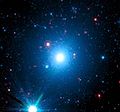| NGC 1404 | |
|---|---|
 NGC 1404 imaged by the Very Large Telescope | |
| Observation data (J2000 epoch) | |
| Constellation | Eridanus |
| Right ascension | 03h 38m 51.917s [1] |
| Declination | −35° 35′ 39.81″ [1] |
| Redshift | 0.006498 [2] |
| Heliocentric radial velocity | 1942 ± 48 km/s [2] |
| Distance | 61 Mly (18.7 Mpc) [3] |
| Apparent magnitude (V) | 10.00 [4] |
| Apparent magnitude (B) | 10.97 [4] |
| Characteristics | |
| Type | E1 [4] |
| Apparent size (V) | 3.3′ × 3.0′ [4] |
| Other designations | |
| MCG -06-09-013, PGC 13433 [2] | |
NGC 1404 is an elliptical galaxy in the Southern constellation Eridanus. It was discovered on November 28, 1837, by the astronomer John Herschel. [5] Based on the tip of the red-giant branch distance indicator, it lies at a distance of approximately 60 million light-years from the Milky Way. [3] It is one of the brightest members of the Fornax Cluster. [6] [7]
